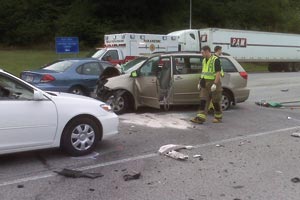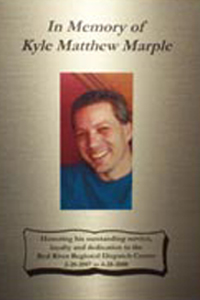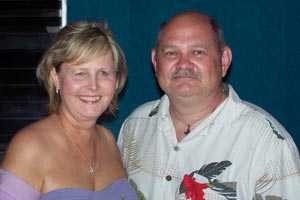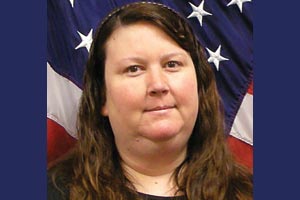A Crisis at the Heart of the PSAP
By Summer Sandness, RPL, Matthew Garrity, RPL, Nathan Heald & Barb Matson
Editor’s note: The following article tells four stories about emergencies that struck at the heart of the comm center, from the perspective of those who were there and most closely affected. These compelling stories remind us that it’s not a matter of if but when an emergency will hit very close to home for comm center personnel. Take this opportunity to ensure your center’s employee emergency contact numbers are up to date and that you have good relationships with other area PSAPs that can backfill for your center when necessary and possibly cover for personnel in the unhappy event of a funeral. Other tips are included at the end of this article.
Always Remembered, Never Forgotten
Summer Sandness, RPL, recounts: It was a sunny spring day—April 19, 2008, to be exact. My co-workers and I had been at work for 55 minutes when the phone rang and our lives and the dispatch center were forever changed.
There were five of us working at the time of the call. Stacy was the calltaker. It was a medical call. I was listening to her follow EMD instructions, when I heard her say “The injured person had been skydiving.”
As I sat at my console, my mo
uth opened up and the words that came out were directed more to myself than to my co-workers in the room, “Please tell me that’s not Kyle.” Kyle Marple is one of the two men who work in dispatch. He is an avid skydiver and instructor with over 2,000 jumps. He had mentioned on his “Friday” that he was looking forward to nice weather so he could go skydiving. Stacy heard me and asked the caller if she knew the name of the patient and repeated the name, Kyle.
My heart fell out of my chest, at least that’s the way it felt. We all looked at each other and started crying. I got on the radio with tears streaming down my face and asked for one of the sergeants to call me in dispatch right away.
Stacy remained as composed as she could on the phone, continuing to give EMD instructions. Another co-worker, Emy, was responsible for dispatching officers and an ambulance to assist in Kyle’s care. Jackie was on the phone dealing with an injury accident involving a motorcycle where the patient was lying in the ditch submerged in water, and the caller was screaming while Angela was dispatching for Moorhead PD.
After hearing me on the radio asking for a sergeant to call up, three officers were up in dispatch within minutes to offer assistance to us. Two of the three had previously been dispatchers, so I had one take over dispatching and one took over a console so I could pull the employees off the floor one by one to speak to the third officer, who happened to be a member of our Peer Assistance Counseling Team (PACT). Other PACT members soon arrived to assist with an immediate debriefing for the employees who were working.
While this was taking place, I contacted our director for Kyle’s emergency contact information. When she answered the phone, all I was able to get out was her name. I started crying to the point where I couldn’t talk. It was like trying to talk to your parents when you have your first relationship breakup.
It was a very long night. All of our administration arrived at the center to help with staffing and contacting all employees to advise them what had happened. The agencies we dispatch for rallied around us to provide much needed support throughout the night and in the days following, as well.
Kyle passed away due to his injuries nine days after his accident.
All employees were given the opportunity to attend either the prayer service or the funeral, while we continued to staff the center 24 hours a day.
A year after Kyle’s death, our center had a plaque made with Kyle’s picture on it. It is displayed in the center in his honor. Kyle will always be remembered and never forgotten.

Teresa Garrity, the wife of Matt Garrity, an emergency services manager, suffered nine broken ribs, a cracked sternum and massive bruising in this head-on collision.
A Personal View
Matthew Garrity, RPL, recounts: It was a typical fall day. Josh Billis and I were just leaving the dispatch center to go to a meeting at the Embassy Suites to work out details for our state APCO conference. Because it was the end of the day, Josh and I were in our own vehicles, and he was following me. I had left my cell phone at work on the charger. As we drove to the meeting, CENCOM got a call for a head-on MVA that had happened in Bella Vista. Because Bella Vista is a secondary PSAP, CENCOM transferred the call to them per protocol. So far it seemed like any other of thousands of calls we take yearly.
What they didn’t know was that the first caller was my wife, Teresa, who was hit head-on by a distracted driver while he played with his radio. He sideswiped a car, swerved into oncoming traffic, hit my wife’s car and spun her around, causing her to hit another car.
A second call came in, and it was from a fe
male who had been running on a jogging track where the accident happened. Terry Van Hook was my wife’s guardian angel that day. She immediately ran over to assist in any way she could. My wife was pinned in the car. Terry stabilized her C spine and started giving orders to other people to get a fire extinguisher and put out a small fire that had started in the truck that hit Teresa.
Terry asked if there was anyone she needed to call. My wife told her I worked for dispatch and to please call my work number and let me know. Terry called and told dispatch what had happened and who was involved.
The dispatcher tried calling me on my work phone, but they heard it ring in my office, so they called Josh to have him tell me. As soon as Josh got the call, he started to pass me on the highway. I looked over and gave him a look like, “Slow down, buddy.” Then I saw the look on his face indicating that something was up. He pointed for me to pull over, and I did. Josh advised me that Teresa was in a bad MVA, that she had head and chest injuries and that they had not transported yet. I knew that at the time of day and with traffic that I would not be able to get to her on scene, so I headed to the nearest hospital, hoping they would take her there.
When I arrived at the hospital, I called CENCOM and asked if they had any more details. They advised that Bella Vista’s ambulance was leaving the scene headed to another hospital. I broke a few laws to get there.
When I arrived, I found out that Teresa had nine broken ribs, a cracked sternum and massive bruising from head to toe. Seeing her there still in a neck brace and lying in the ER, I was first thankful she was alive and then was very thankful she had been in the good hands of all the dispatchers, EMS personnel and the bystander who had helped her.
There’s no way I can thank them enough—not only for how they handled this call but for the thousands of calls we take all the time. I try, but as you know it’s a job that for the most part goes unnoticed by those we serve and those we dispatch for. They are trained professionals and should be recognized as such all across America for the outstanding service they perform daily. You don’t hear many kids saying, “When I grow up I want to be a dispatcher.” They want to be a police officer or a firefighter, but without us they can’t do their job.
This gave me a whole different view of what our job is on a daily basis.
Teamwork
Nathan Heald, director, Siloam Springs (Ark.) Dispatch, recounts: Stacy Martin had always wanted to become our EMD Instructor. She had been a certified paramedic for all of those years employed with our agency, so we agreed the time was right. Stacy began early in 2009 taking the new APCO Public Safety Online course. She followed that with APCO EMD online and then APCO EMD Instructor. She wrote the following introduction for the APCO Telecommunicator course:
“Hello, my name is Stacy Martin, and I currently work as a 9-1-1 dispatcher for the City of Siloam Springs, Siloam Springs, Arkansas. Personal information: Well, I am married to the love of my life for 20 years this June. We have one daughter, two-and-7/8 horses (my mare is fixing to foal within two weeks) and a cute chocolate lab puppy. We have a small farm just North of Siloam Springs about five miles. I have been a 9-1-1 dispatcher for quite some time, but left in April 2004 only to come back in February 2009. I started dispatching in November 1994 and loved every minute of it. Dispatching, for me, has definitely had its good times and its bad, but all-in-all, it is the best job I have ever had.”
During the last part of her training, Stacy accidentally fell down some steps while at home. She suffered an ankle injury. Within a few weeks, Stacy was told she had to have surgery and did so. A few weeks later Stacy mentioned that she was fighting a blood clot. Stacy was always a positive thinker and didn’t like dwelling on the bad possibilities.
While out on medical leave and a few personal days gained from all of her hard work on her APCO projects, Stacy became ill in the early morning hours of Nov. 15, 2009. She was transported to the Siloam Springs Memorial Hospital via ambulance from the Siloam Springs Fire Department. It is now that I make special note that her husband, Jon Martin, is a full-time paramedic/firefighter with them and was home at the time of the incident.
Upon arrival at the hospital, Stacy went into cardiac arrest. The medical staff went to work on her but was unable to revive her.
Stacy is survived by her husband Jon and daughter Corey.
As one can imagine, our entire police and fire departments were affected. I will never forget the phone call I received that morning from my own center, which, by the way, had to dispatch the squad and first responders.
I lost not only an employee, but a friend. Stacy and I had gone to high school together and graduated in 1986.
On Nov. 19, 2009, a memorial service was held in her memory at New Life Tabernacle Church in Siloam Springs. As you can imagine, all current and former employees were in attendance.
I would like to thank Matt Garrity and CENCOM for providing two members of its TERT (Telecommunicator Emergency Response Taskforce) team to help cover our communications room during the memorial service. This unfortunate incident proved that TERT is a valuable asset.
Stacy Martin was the department’s first ever Telecommunicator of the Year in 1999 and was also selected posthumously as our 2009 Telecommunicator of the Year. We have also created a new award, “The 414 Award,” that will be given annually to a telecommunicator for their outstanding efforts in our EMD program.
Matt Garrity adds: The above is another example of how the loss of one of our own is a loss for all of us. We are brothers and sisters in public safety. Even though this happened at another PSAP, we are all affected and can rise to the occasion to help our brothers and sisters in a time of need. TERT is one way we can help each other on a national scale down to a local mutual aid of a neighboring PSAP.

On Nov. 29, 2009, four Lakewood, Wash., police officers were killed in the line of duty. The communications team who handled the response did not falter as they did what was required of them. (Photo Cary Ulrich)

A funeral procession was held for the four Lakewood, Wash., police officers killed in the line of duty. (Photo Cary Ulrich)
A Tragic Loss
Barb Matson, communications supervisor, LESA, Tacoma, Wash., recounts: At 0816 on Sunday, Nov. 29, 2009, four Lakewood police officers were murdered while beginning their shift turnout at a Forza Coffee shop. The team of communications personnel handled the incident calmly and professionally, an incident that none of us could ever have imagined or dreamed of in our worst nightmares. As the incident and its devastating details unfolded, this crew went through a few moments of false hope to utter disbelief, but they did not falter in the performance of their jobs.
For any of you who have worked an officer down call, you know how time seems to slow. This crew worked through the event as a team, checking on each other, taking on duties not normally in their scope, dropping jurisdictional issues and just plain getting whatever resource was needed from whatever corner they could pull it.
True professionals moved through the onslaught of tasks, notifications and callouts, expeditiously so those in the field would have everything they needed to bring honor to the fallen officers, help to their families and aid in the efforts to capture the suspect who was still at large. I noted that somehow we had silently formed a new distinct crew—veterans by fate—of a fourfold sorrow.
This incident affected our agency for weeks … continuing to support each other and debrief each other. I will always be impressed by the strengths I saw present themselves during this event, the compassion and direction each employee offered the other.
I never want to work through another incident even remotely similar to the death of four officers, but if I had to face another shift from hell, I’d gladly do so with the same exact crew.
Be Prepared
The four stories above are examples of why we are so proud to be in the job we love. We are the first, first responders on scene even though we are not there. We help the citizens that call in; we help the officers and responders who are going to the scene; we help each other when it hits the heart of our PSAP. Never forget the fallen on 9/11 in New York and those who answered the call; we stand by and with each other.
Be prepared. Things you can do include the following: Have a list of chaplains, counselors, Employee Assistance Program (EAP), Critical Incident Stress Management (CISM) and peer counselors readily available. Sometimes all it takes to alleviate pain and stress is to talk to a friend. Whatever counseling model your agency uses for crisis situations, have it ready and make it available—the sooner the better.
Get involved with TERT, if your state is not already. Even though it is not a national call out, the mutual aid of PSAPs helping PSAPs in times of emergency is what TERT is all about. Build those bonds with your neighboring agencies.
Take time out of your day to thank a dispatcher, you never know when it will be your call they have to answer.
About the Authors
Summer Sandness, RPL, is a shift supervisor for the Red River Regional Dispatch Center in Fargo, N.D. Contact her at ssandness@rrrdc.com.
Matthew Garrity, RPL, is manager of emergency services for Benton County, Ark., and the APCO Arkansas president. Contact him at mgarrity@co.benton.ar.us.
Nathan Heald is director of Siloam Springs (Ark.) Dispatch.
Barb Matson is a communications supervisor for the Law Enforcement Support Agency in Tacoma, Wash.
Originally published in Public Safety Communications, 76(8):42-45, August 2010.




